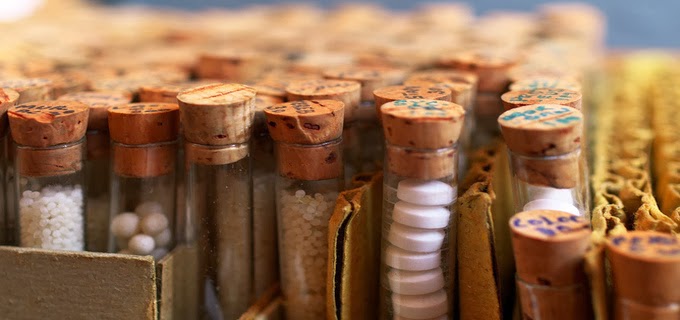Inflammation of the eyes should be immediately treated
with Aconite and Belladonna combined, in any potency. If there is no immediate relief,
then refer to the following chapters where eye diseases have been specifically
mentioned:
Aesculus Euphrasia
Aethusa Gelsemium
Alumina Hepar
Sulph
Apis Millefolium
Arnica Psorinum
Conium
All the above remedies are of immense value. A physician
would find most eye diseases covered in these remedies. However a more detailed
treatment of some of them is described below.
When the blood vessels of the eyes become weak and cannot tolerate even
slight pressure, the eyes remain permanently congested and red; some doctors
call it piles of the eyes. In this situation, Aesculus 30 is the best. If
untreated, there may be a danger of losing the eyesight. Aesculus is also useful in the treatment of
nodular swellings resulting from chronic inflammation of the eye. Sometimes,
the eyelids become swollen and inverted (inside out) exposing the deep red surface
and look horrible. The eyelashes start falling out. In this condition,
Psorinum, Hepar Sulph and Alumina are extremely useful. In Aethusa, the eyes are hypersensitive to
light and the margins of the eyelids become swollen. The eyeballs roll from
side to side and become drawn downwards.
In Apis, there is puffiness and whole of the eye becomes
swollen,looking like raw meat. Both Euphrasia and Belladonna
resemble each other in the redness of the eye and its severity. In
Euphrasia, the watery discharge is very corrosive Belladonna is also useful in the treatment of high eye
pressure.
Gelsemium is also significantly useful, in reducing the
pressure. Calcarea Phos 6X and
Gelsemium 6X combined are useful in Glaucoma. Sometimes, the eyes produce a
watery discharge which becomes yellowish when the infection becomes chronic.
Calcarea Carb is useful in this condition. In weakness of the eyes resulting
from tiredness and pressure, Calcarea Carb is useful, but Onosmodium is more
effective for tired eyes.
Carbonium Sulph is the ideal treatment for infections of
the eyelids. When the eyes become sore
and sticky, or there is a thready pustular discharge, or swellings form over
the eyes which are itchy and burning, then Carbonium Sulph should be given if
other remedies do not help.
Eczema of the eyelids, the feeling of heat, heaviness and
discomfort, watering of the eyes mixed with beads of pus, swelling of the
eyelids, hypersensitivity to light, weakness of the eyesight and colour blindness,
are all the symptoms and signs of Carbonium Sulph. Steady progressive drooping of the eyelids (ptosis) and green
spots before the eyes need to be treated with Causticum. Extreme sensitivity to light, watering and
dizziness (getting worse on lying down) are suggestive of Conium.
Yellowness of eyes, dark rings around them, a burning
sensation in them, stabbing pain, blurring of vision, the progressive weakness
of the eyesight, the tendency to bleed and photophobia, are all the symptoms of
Crotalus.Redness of the eyes along with the formation of ulcers,
pimples and blisters on the eyelids are the symptoms of Croton. Other symptoms of
Croton are flashes of lightning and stars before the eyes, dark spots appearing
on stooping, pain, engorgement of the eyes with blood as if sand particles are
causing inflammation in the eyes and severe discomfort on carrying out fine
eye-work, like in Ruta. If, on doing fine eye-work, the head hurts instead of
the eyes, then Onosmodium is more useful.
For the drooping of the eyelids resulting from paralysis,
one should study Agaricus, Plumbum, Senega and Causticum. Tiny spots found on
the cornea are a specific sign of Senega.
Silicea is very useful in the treatment of corneal ulcers. Calcarea Fluor
is also deeply related to eye ailments. The pain in the eyes on sudden exposure
to cold should be treated with Spigelia. For further details, please read under
Spigelia.
Neuralgic pain in the eye responds very well to Lac Felinum
which is prepared from cat’s milk. Pain in the eyes, redness, watering, increasing
discomfort on opening and closing the eyes and pain on reading, should ideally
be treated with Strontium Carb. If the
symptoms are more marked in the right eye, such as blurring of vision, or
weakness of the eyesight with discharge, then Tarentula should be used. When
dark spots appear before the eyes, and there is dimness of the eyesight on
opening the eye, with piercing pain and burning, then Natrum Carb should be
used.
Besides the above, the following chapters should also be
studied:
Argentum Nitricum Lilium Tig
Aurum Metallicum Lycopodium
Baryta Carb Medorrhinum
Borax Mercurius
Calcarea Fluor Millefollium
Calcarea Sulphurica Muriatic Acid
Chininum Ars Natrum Carb
Cicuta Virosa Natrum Phos
Cocculus Natrum Sulph
Crotalus Nitric Acid
Cuprum Phosphorus
Cyclamen Pulsatilla
Glonoine Rhus Tox
Graphites Sanguinaria
Hydrastis Senega
Kali Carb Sulphur
Lachesis Zincum Metallicum
Ledum Zincum
Sulph





